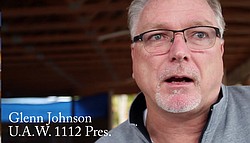Labor leaders: Unions still carry clout in elections
YOUNGSTOWN
UAW And The 2016 Presidential Election

UAW 1112 members speak out about the 2016 Presidential race.
Labor unions have lost membership here and across the nation, but local union leaders say that organized labor has the power to impact the Nov. 8 presidential election.
Union membership fell from 35 percent of the workforce in organized labor’s heyday, in the mid-1950s, to about 11 percent in 2014 and 2015, according to the U.S. Bureau of Labor Statistics.
Despite loss in membership, organized labor is still a “force to be reckoned with,” said William Padisak Jr., president of the Mahoning-Trumbull AFL-CIO Labor Council and a field representative for the Northeast Ohio Region of the Ohio Association of Public School Employees.
Padisak said a lot of members are willing to go out and talk to people and they are doing their traditional leafleting.
“We find one-on-one communications is the best way to connect with union members and the community,” Padisak said.
“Union members don’t like to be told who to vote for. Instead, we encourage them to register and vote. We tell them who we think is the better candidate, and why, through work-site representatives. That’s who the members have a lot of faith in,” Padisak said. “We’re a force in the election because a high percentage of union members vote. That is why candidates still seek our endorsement,” he said.
Robert Morales, president of United Autoworkers of America Local 1714, which represents workers in GM Lords- town’s fabricating plant, said, “We support those who support us. We are smaller in numbers, but we have a big retirement vote.”
The other thing the UAW offers is the Volunteer Community Action Program, under which members are able to contribute money which VCAP contributes to candidates friendly to the UAW and organized labor, said Glenn Johnson, president of UAW Local 1112, which represents workers in the assembly division at the Lordstown GM Complex.
Johnson said Local 1112 is conducting an aggressive member-to-member campaign, with leaflets and social media, and talking to members and supporters person-to-person to get out the vote.
“No individual union has the clout to affect the election, but jointly we’re a force,” Johnson said.
Service Employees International Union, which represents almost 1.9 million workers in the U.S. and Canada, is working to restore collective power for workers and rebuilding the nation’s middle class, said Anthony A. Caldwell, director of public affairs for SEIU District 1199, which represents members in Ohio, West Virginia and Kentucky.
“When working people stick together and take action together, we win,” Caldwell said.
SDLqThat’s why this election, the most consequential of our lifetime, is so important. We need to build on our successes while we continue work to lift up those who are struggling. The stakes in this election couldn’t be higher nor the contrasts more stark,” he said.
Caldwell said thousands of SEIU members took to the streets beginning Labor Day to talk with their friends, family members and neighbors about why the 2016 election is so important.
“Our movement of underpaid service and care workers is an unstoppable force in this election. It has already helped pave the way for one of the boldest, most progressive Democratic Party platforms in history and moved candidates on our issues,” Caldwell said.
Although union endorsement still plays a role in politics, union officials say they also face other obstacles besides dwindling membership.
For example, in 2009 when General Motors was recovering after filing for bankruptcy protection, business took advantage of the downturn as an opportune time to go to the unions and seek concessions, Morales said.
“We took wage freezes; medical benefits were reduced; and cost-of-living [adjustments] was taken away. We’ve made strides in getting some of these things back,” he said.
“When we negotiate, we have to look at what’s best for everybody. You do what you think is best for the union membership, the company and the community,” Morales said.
“Changes in technology are partly responsible for the decline in manufacturing employment, for managers as well as hourly workers. But, this is usually rationalized as ‘productivity’ increases,’” said Thomas E. Leary, Ph.D., assistant professor of history at Youngstown State University, whose special interest is the history of work, workplaces and work processes.
The decline of employment in former union strongholds and the continuing difficulties in organizing sectors such as service workers have combined, since the 1980s, to erode membership and power, Leary said.
What organized labor can do to make a comeback is a “discussion we are having,” Padisak said.
Part of the problem is that organized labor needs to communicate better to workers and the community what it has done and is doing for workers, he said.
Morales said Local 1714 educates new members about what unions are about and the importance of organized labor.
He said organized labor has brought safety to the workplace, 40-hour work- weeks, health benefits, retirement pensions and seniority rights, to name a few accomplishments.
“We talk to new members about the importance of the role employees play to continue to build cars in Lords- town. It is important to do what we can to be here for future generations,” Morales said.
 43
43
